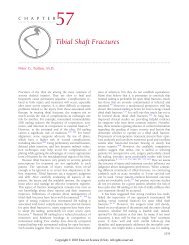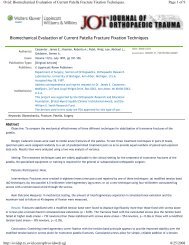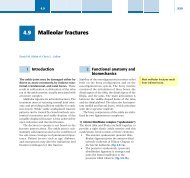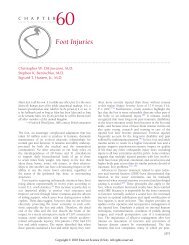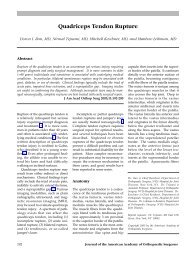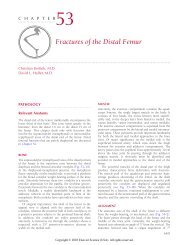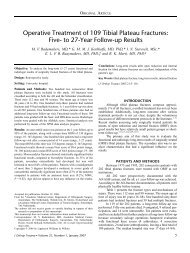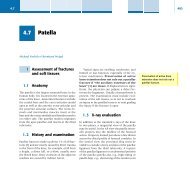Pelvic Disruption: Assessment and Classification
Pelvic Disruption: Assessment and Classification
Pelvic Disruption: Assessment and Classification
You also want an ePaper? Increase the reach of your titles
YUMPU automatically turns print PDFs into web optimized ePapers that Google loves.
20 Pennal, et al.the most common lateral compression injury.It was accompanied by the largestnumber of associated injuries <strong>and</strong> complications,indicating the severe violence causingthe injury.Type D: Miscellaneous. Two other patternsare recognized. In the first type, thesuperior pubic ramus buckles <strong>and</strong> the medialfragment rotates through the disruptedsymphysis (Figs. 13A <strong>and</strong> 13B). This causesrotation of the medial fragment into theperineum. The fragment may be felt infemale patients through the vagina. Thisinjury has been seen more commonly infemales than in males. Because of thedisplacement into the perineum, this fragmentrequires reduction.A rare type of lateral compression injuryoccurs when the anterior disruption isthrough the symphysis pubis <strong>and</strong> the forcecauses the symphysis to override <strong>and</strong> lock.Attempts at reduction may be extremelydifficult owing to the tremendous forcesnecessary to cause this injury.VERTICAL SHEARThe fracture pattern in this group, describedby Malgaigne (1855),3 consists of aClinical Orthopaedics<strong>and</strong> Related Researchfracture anteriorly through both rami or thesymphysis pubis in association with massiveposterior disruption either through thesacrum, the sacroiliac joint or the ilium(Figs. 14A <strong>and</strong> 14B). These fractures arealways the result of severe trauma, that is,falls from heights, motor vehicle accidents<strong>and</strong> crushing injuries in the mining or loggingindustries. The displacement suggests thatthe forces involved are in the vertical plane,<strong>and</strong> therefore, shearing in nature.The feature of the displacement in thisfracture dislocation which requires emphasis,in order to obtain correction, is theposterior displacement of the affected hemipelvisseen on the inlet view, <strong>and</strong> superiordisplacement as seen on the tangential view.Since the inclination of the pelvis to thevertical plane is 40", vertical shear mustresult in posterior as well as upwarddisplacement.Many types of fracture dislocations in themiscellaneous category defy precise classification<strong>and</strong> are, because of complex forceresolutions, usually the result of motorvehicle accidents. We have seen completesacroiliac bilateral dislocations <strong>and</strong> otherpatterns. However, the basic concept of theFIGS. 13A <strong>and</strong> 13B. (Left) Diagram of an unusual type of lateral compression injury characterizedby buckling of the superior pubic ramus <strong>and</strong> disruption of the symphysis. The medial fragment rotatesinferiorly <strong>and</strong> anteriorly. (Right) Anteroposterior projection of the same lesion.



